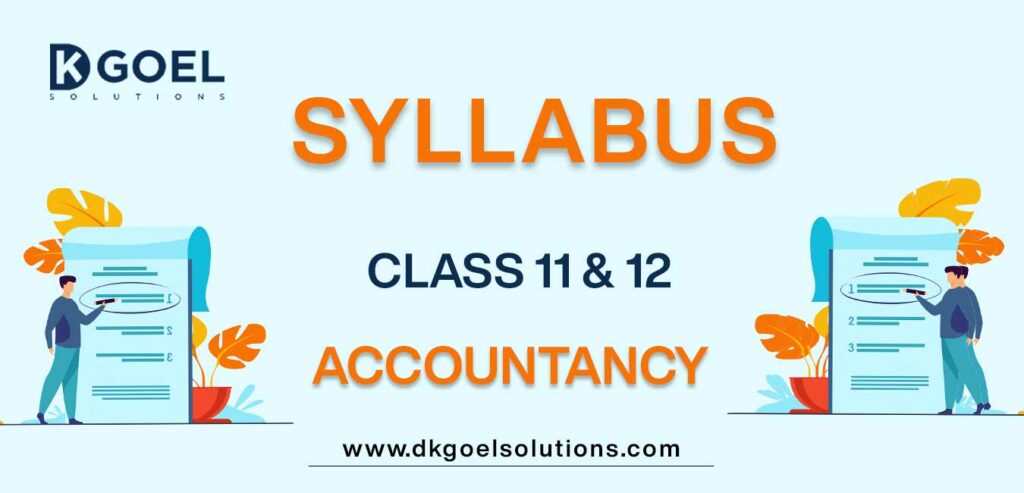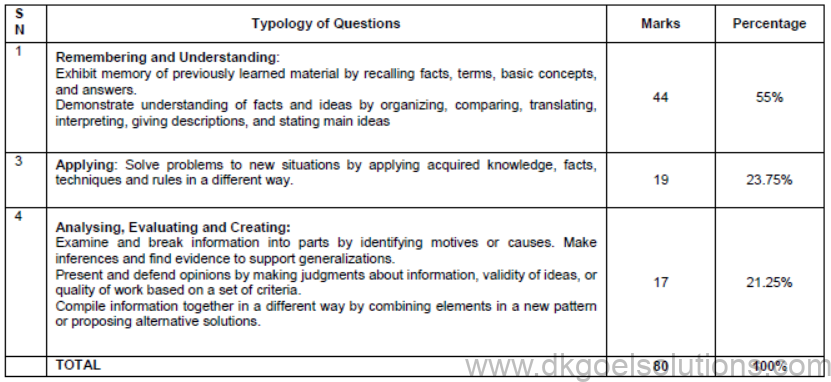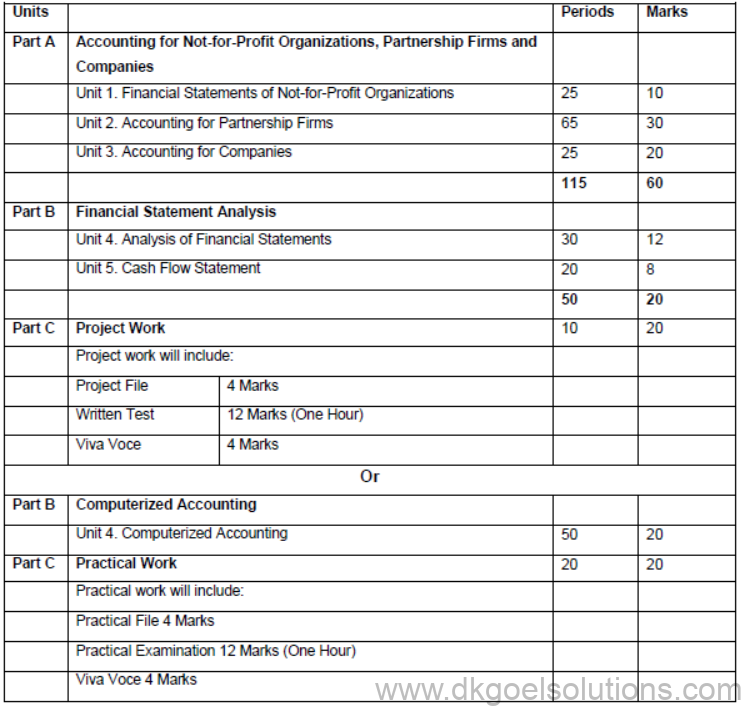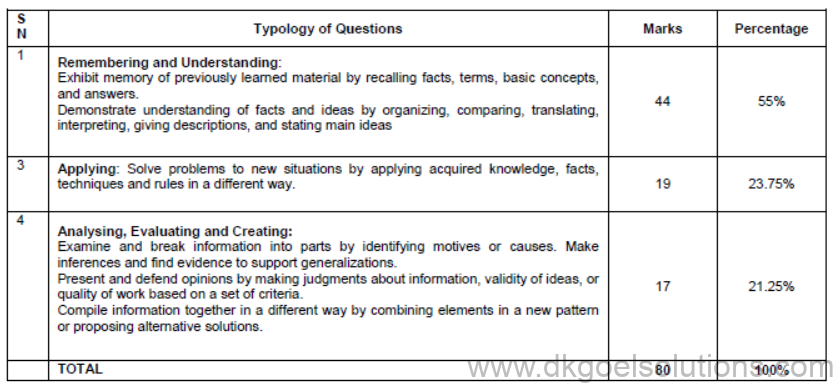Syllabus for Accountancy Class 11 and 12
Are you searching for Class 11 and 12 Accountancy syllabus, you have reached the correct page as we have provided the latest syllabus issued by CBSE and NCERT for the current academic year below. See the curriculum below based on which you can plan your studies for this year. Going through the below curriculum and then NCERT book for Class 12 Accounts if also very important. Also refer to DK Goel Class 12 Solutions

PART A: FINANCIAL ACCOUNTING – I
Unit-1: Theoretical Frame Work
Units/Topics
Introduction to Accounting
•Accounting- concept, objectives, advantages and limitations, types of accounting information; users of accounting information and their needs. Qualitative Characteristics of Accounting Information. Role of Accounting in Business.
• Basic Accounting Terms- Business Transaction, Capital, Drawings. Liabilities (Non Current and Current). Assets (Non Current, Current); Fixed assets (Tangible and Intangible), Expenditure (Capital and Revenue), Expense, Income, Profit, Gain, Loss, Purchase, Sales, Goods, Stock, Debtor, Creditor, Voucher, Discount (Trade discount and Cash Discount)
Theory Base of Accounting
• Fundamental accounting assumptions: GAAP: Concept
• Business Entity, Money Measurement, Going Concern, Accounting Period, Cost Concept, Dual Aspect, Revenue Recognition, Matching, Full Disclosure, Consistency, Conservatism, Materiality and Objectivity
• System of Accounting. Basis of Accounting: cash basis and accrual basis
• Accounting Standards: Applicability in IndAS
• Need of IFRS
• Goods and Services Tax (GST): Characteristics and Objective.
Learning Outcomes
After going through this Unit, the students will be able to:
• describe the meaning, significance, objectives, advantages and limitations of accounting in the modem economic environment with varied types of business and non-business economic entities.
• identify / recognise the individual(s) and entities that use accounting information for serving their needs of decision making.
• explain the various terms used in accounting and differentiate between different related terms like current and non-current, capital and revenue.
• give examples of terms like business transaction, liabilities, assets, expenditure and purchases.
• explain that sales/purchases include both cash and credit sales/purchases relating to the accounting year.
• differentiate among income, profits and gains.
• state the meaning of fundamental accounting assumptions and their relevance in accounting.
• describe the meaning of accounting assumptions and the situation in which an assumption is applied during the accounting process.
• explain the meaning and objectives of accounting standards.
• appreciate that various accounting standards developed nationally and globally are in practice for bringing parity in the accounting treatment of different items.
• acknowledge the fact that recording of accounting transactions follows double entry system.
• explain the bases of recording accounting transaction and to appreciate that accrual basis is a better basis for depicting the correct financial position of an enterprise.
• Understand the need of IFRS
• Explain the meaning, objective and characteristic of GST.
Unit-2: Accounting Process
Recording of Business Transactions
• Voucher and Transactions: Source documents and Vouchers, Preparation of Vouchers, Accounting Equation Approach: Meaning and Analysis, Rules of Debit and Credit. (Traditional and Modern Approach)
• Recording of Transactions: Books of Original Entry- Journal
• Special Purpose books:
• Cash Book: Simple, cash book with bank column and petty cashbook
• Purchases book
• Sales book
• Purchases return book
• Sales return book
Note: Including trade discount, freight and cartage expenses for simple GST calculation.
• Ledger: Format, Posting from journal and subsidiary books, Balancing of accounts Bank Reconciliation Statement:
• Need and preparation Depreciation, Provisions and Reserves
• Depreciation: Concept, Features, Causes, factors
• Other similar terms: Depletion and Amortisation
• Methods of Depreciation:
i. Straight Line Method (SLM)
ii. Written Down Value Method (WDV)
Note: Excluding change of method
• Difference between SLM and WDV;
Advantages of SLM and WDV
• Accounting treatment of depreciation
i. Charging to asset account
ii. Creating provision for
depreciation/accumulated depreciation account
iii. Treatment for disposal of asset
• Provisions and Reserves: Difference
• Types of Reserves:
i. Revenue reserve
ii. Capital reserve
iii. General reserve
iv. Specific reserve
v. Secret Reserve
• Difference between capital and revenue reserve
Accounting for Bills of Exchange
• Bill of exchange and Promissory Note: Definition, Specimen, Features, Parties.
• Difference between Bill of Exchange and Promissory Note
• Terms in Bill of Exchange:
i. Term of Bill
ii. Accommodation bill (concept)
iii. Days of Grace
iv. Date of maturity
v. Discounting of bill
vi. Endorsement of bill
vii. Bill after due date
viii. Negotiation
ix. Bill sent for collection
x. Dishonour of bill
• Accounting Treatment
Note: excluding accounting treatment for accommodation bill
Trial balance and Rectification of Errors
• Trial balance: objectives and preparation
(Scope: Trial balance with balance method only)
• Errors: types-errors of omission, commission, principles, and compensating; their effect on Trial Balance.
• Detection and rectification of errors; preparation of suspense account.
Learning Outcomes
After going through this Unit, the students will be able to:
• explain the concept of accounting equation and appreciate that every transaction affects either both the sides of the equation or a positive effect on one item and a negative effect on another item on the same side of accounting equation.
• explain the effect of a transaction (increase or decrease) on the assets, liabilities, capital, revenue and expenses.
• appreciate that on the basis of source documents, accounting vouchers are prepared for recording transaction in the books of accounts.
• develop the understanding of recording of transactions in journal and the skill of calculating GST.
• explain the purpose of maintaining a Cash Book and develop the skill of preparing the format of different types of cash books and the method of recording cash transactions in Cash book.
• describe the method of recording transactions other than cash transactions as per their nature in different subsidiary books .
• appreciate that at times bank balance as indicated by cash book is different from the bank balance as shown by the pass book / bank statement and to reconcile both the balances, bank reconciliation statement is prepared.
• develop understanding of preparing bank reconciliation statement.
• appreciate that for ascertaining the position of individual accounts, transactions are posted from subsidiary books and journal proper into the concerned accounts in the ledger and develop the skill of ledger posting.
• explain the necessity of providing depreciation and develop the skill of using different methods for computing depreciation.
• understand the accounting treatment of providing depreciation directly to the concerned asset account or by creating provision for depreciation account.
• appreciate the method of asset disposal through the concerned asset account or by preparing asset disposal account.
• appreciate the need for creating reserves and also making provisions for events which may belong to the current year but may happen in next year.
• appreciate the difference between reserve and reserve fund.
• acquire the knowledge of using bills of exchange and promissory notes for financing business transactions;
• understand the meaning and distinctive features of these instruments and develop the skills of their preparation.
• state the meaning of different terms used in bills of exchange and their implication in accounting.
• explain the method of recording of bill transactions.
• state the need and objectives of preparing trial balance and develop the skill of preparing trial balance.
• appreciate that errors may be committed during the process of accounting.
• understand the meaning of different types of errors and their effect on trial balance.
• develop the skill of identification and location of errors and their rectification and preparation of suspense account.

Part B: Financial Accounting – II
Unit 3: Financial Statements of Sole Proprietorship
Units/Topics
Financial Statements
Meaning, objectives and importance; Revenue and Capital Receipts; Revenue and Capital Expenditure;
Deferred Revenue expenditure.
Trading and Profit and Loss Account: Gross Profit,
Operating profit and Net profit. Preparation.
Balance Sheet: need, grouping and marshalling of assets and liabilities. Preparation.
Adjustments in preparation of financial statements with respect to closing stock, outstanding expenses, prepaid expenses, accrued income, income received in advance, depreciation, bad debts, provision for doubtful debts, provision for discount on debtors, Abnormal loss, Goods taken for personal use/staff welfare, interest on capital and managers commission.
Preparation of Trading and Profit and Loss account and Balance Sheet of a sole proprietorship with adjustments.
Incomplete Records
Features, reasons and limitations.
Ascertainment of Profit/Loss by Statement of Affairs method.
Learning Outcomes
After going through this Unit, the students will be able to:
• purpose of preparing financial statements.
• state the meaning of gross profit, operating profit and net profit and develop the skill of preparing trading and profit and loss account.
• explain the need for preparing balance sheet.
• understand the technique of grouping and marshalling of assets and liabilities.
• appreciate that there may be certain items other than those shown in trial balance which may need adjustments while preparing financial statements.
• develop the understanding and skill to do adjustments for items and their presentation in financial statements like depreciation, closing stock, provisions, abnormal loss etc.
• develop the skill of preparation of trading and profit and loss account and balance sheet.
• state the meaning of incomplete records and their uses and limitations.
Unit 4: Computers in Accounting
• Introduction to computer and accounting information system {AIS}: Introduction to computers (elements, capabilities, limitations of computer system)
• Automation of accounting process: meaning
Scope:
(i) The scope of the unit is to understand accounting
as an information system for the generation of
accounting information and preparation of accounting
reports.
(ii) It is presumed that the working knowledge of any
appropriate accounting software will be given to the
students to help them learn basic accounting
operations on computers.
Learning Outcomes
After going through this Unit, the students will be able to:
• state the meaning of a computer, describe its components, capabilities and limitations.
• state the meaning of accounting information system.
• appreciate the need for use of computers in accounting for preparing accounting reports.
• develop the understanding of comparing the manual and computerized accounting process and appreciate the advantages and limitations of automation.
Part C: Project Work (Any One)
1. Collection of source documents, preparation of vouchers, recording of transactions with the help of vouchers.
2. Preparation of Bank Reconciliation Statement with the given cash book and the pass book with twenty to twenty-five transactions.
3. Comprehensive project of any sole proprietorship business. This may state with journal entries and their ledgering, preparation of Trial balance. Trading and Profit and Loss Account and Balance Sheet. Expenses,
incomes and profit (loss), assets and liabilities are to be depicted using pie chart / bar diagram.

Class-XII

Part A: Accounting for Not-for-Profit Organizations, Partnership Firms and Companies
Unit 1: Financial Statements of Not-for-Profit Organizations
Units/Topics
• Not-for-profit organizations: concept.
• Receipts and Payments Account: features and preparation.
• Income and Expenditure Account: features, preparation of income and expenditure account and balance sheet from the given receipts and payments account with additional information.
Scope:
(i) Adjustments in a question should not exceed 3 or 4 in number and restricted to subscriptions, consumption of consumables, funds and sale of
assets/ old material/funds.
(ii) Entrance/admission fees and general donations are to be treated as revenue receipts.
(iii) Trading Account of incidental activities is not to be prepared.
Learning Outcomes
After going through this Unit, the students will be able to:
• state the meaning of a Not-for-profit organisation and its distinction from a profit making entity.
• state the meaning of receipts and payments account, and understanding its features.
• develop the understanding and skill of preparing receipts and payments account.
• state the meaning of income and expenditure account and understand its features.
• develop the understanding and skill of preparing income and expenditure account and balance sheet of a not-for-profit organisation with the help of given receipts and payments account and additional information.
Unit 2: Accounting for Partnership Firms
Units/Topics
• Partnership: features, Partnership Deed.
• Provisions of the Indian Partnership Act 1932 in the absence of partnership deed.
• Fixed v/s fluctuating capital accounts. Preparation of Profit and Loss Appropriation account- division of profit among partners, guarantee of profits.
• Past adjustments (relating to interest on capital, interest on drawing, salary and profit sharing ratio).
• Goodwill: nature, factors affecting and methods of valuation – average profit, super profit and capitalization.
Note: Interest on partner’s loan is to be treated as a charge against profits.
Goodwill to be adjusted through partners capital/ current account (AS 26)
Accounting for Partnership firms – Reconstitution and Dissolution.
• Change in the Profit Sharing Ratio among the existing partners – sacrificing ratio, gaining ratio, accounting for revaluation of assets and reassessment of liabilities and treatment of reserves and accumulated profits. Preparation of revaluation account and balance sheet.
• Admission of a partner – effect of admission of a partner on change in the profit sharing ratio, treatment of goodwill (as per AS 26), treatment for revaluation of assets and reassessment of liabilities, treatment of reserves and accumulated profits
• Retirement and death of a partner: effect of retirement / death of a partner on change in profit sharing ratio, treatment of goodwill (as per AS 26), treatment for revaluation of assets and reassessment of liabilities, adjustment of accumulated profits and reserves and preparation of balance sheet.
• Calculation of deceased partner’s share of profit till the date of death.
• Dissolution of a partnership firm: meaning of dissolution of partnership and partnership firm, types of dissolution of a firm. Settlement of accounts – preparation of realization account, and other related accounts: capital accounts of partners and cash/bank a/c (excluding memorandum balance sheet, piecemeal distribution, sale to a company and insolvency of partner(s)).
Note:
(i) The realized value of each asset must be given at the time of dissolution.
(ii) In case, the realization expenses are borne by a partner, clear indication should be given regarding the payment thereof.
Learning Outcomes
After going through this Unit, the students will be able to:
• state the meaning of partnership, partnership firm and partnership deed.
• describe the characteristic features of partnership and the contents of partnership deed.
• discuss the significance of provision of Partnership Act in the absence of partnership deed.
• differentiate between fixed and fluctuating capital, outline the process and develop the understanding and skill of preparation of Profit and Loss Appropriation Account.
• develop the understanding and skill of preparation profit and loss appropriation account involving guarantee of profits.
• develop the understanding and skill of making past adjustments.
• state the meaning, nature and factors affecting goodwill
• develop the understanding and skill of valuation of goodwill using different methods.
• state the meaning of sacrificing ratio, gaining ratio and the change in profit sharing ratio among existing partners.
• develop the understanding of accounting treatment of revaluation assets and reassessment of liabilities and treatment of reserves and accumulated profits by preparing revaluation account and balance sheet.
• explain the effect of change in profit sharing ratio on admission of a new partner.
• develop the understanding and skill of treatment of goodwill as per AS-26, treatment of revaluation of assets and re-assessment of liabilities, treatment of reserves and accumulated profits, adjustment of capital accounts and preparation of balance sheet of the new firm.
• explain the effect of retirement / death of a partner on change in profit sharing ratio.
• develop the understanding of accounting treatment of goodwill, revaluation of assets and re-assessment of liabilities and adjustment of accumulated profits and reserves on retirement of a partner.
• develop the skill of calculation of deceased partner’s share till the time of his death.
• discuss the preparation of the capital accounts of the remaining partners and the balance sheet of the firm after retirement / death of a partner.
• understand the situations under which a partnership firm can be dissolved.
• develop the understanding of preparation of realisation account and other related accounts.
Unit – 3 Accounting for Companies
Units/ Topics
Accounting for Share Capital
• Share and share capital: nature and types.
• Accounting for share capital: issue and allotment of equity and preferences shares. Public subscription of shares – over subscription and under subscription of shares; issue at par and at premium, calls in advance and arrears (excluding interest), issue of shares for consideration other than cash.
• Concept of Private Placement and Employee Stock Option Plan (ESOP).
• Accounting treatment of forfeiture and reissue of shares.
• Disclosure of share capital in the Balance Sheet of a company.
Accounting for Debentures
• Debentures: Issue of debentures at par, at a premium and at a discount. Issue of debentures for consideration other than cash; Issue of debentures with terms of redemption; debentures as collateral securityconcept,
interest on debentures. Writing off discount / loss on issue of debentures.
Note: Discount or loss on issue of debentures to be written off in the year debentures are allotted from Security Premium Reserve (if it exists) and then from Statement of Profit and Loss as Financial Cost (AS 16).
Note: Related sections of the Companies Act, 2013 will apply.
Learning Outcomes
After going through this Unit, the students will be able to:
• state the meaning of share and share capital and differentiate between equity shares and preference shares and different types of share capital.
• understand the meaning of private placement of shares and Employee Stock Option Plan.
• explain the accounting treatment of share capital transactions regarding issue of shares.
• develop the understanding of accounting treatment of forfeiture and re-issue of forfeited shares.
• describe the presentation of share capital in the balance sheet of the company as per schedule III part I of the Companies Act 2013.
• explain the accounting treatment of different categories of transactions related to issue of debentures.
• develop the understanding and skill of writing of discount / loss on issue of debentures.
• understand the concept of collateral security and its presentation in balance sheet.
• develop the skill of calculating interest on debentures and its accounting treatment.
• state the meaning of redemption of debentures.
Part B: Financial Statement Analysis
Unit 4: Analysis of Financial Statements
Units/Topics
Financial statements of a Company:
Statement of Profit and Loss and Balance Sheet in prescribed form with major headings and sub headings (as per Schedule III to the Companies Act,
2013)
Note: Exceptional items, extraordinary items and profit (loss) from discontinued operations are excluded.
• Financial Statement Analysis: Objectives, importance and limitations.
• Tools for Financial Statement Analysis: Comparative statements, common size statements, cash flow analysis, ratio analysis.
• Accounting Ratios: Meaning, Objectives, classification and computation.
• Liquidity Ratios: Current ratio and Quick ratio.
• Solvency Ratios: Debt to Equity Ratio, Total Asset to Debt Ratio, Proprietary Ratio and Interest Coverage Ratio.
• Activity Ratios: Inventory Turnover Ratio, Trade Receivables Turnover Ratio, Trade Payables Turnover Ratio and Working Capital Turnover Ratio.
• Profitability Ratios: Gross Profit Ratio, Operating Ratio, Operating Profit Ratio, Net Profit Ratio and Return on Investment.
Learning Outcomes
After going through this Unit, the students will be able to:
• develop the understanding of major headings and sub-headings (as per Schedule III to the Companies Act, 2013) of balance sheet as per the prescribed norms / formats.
• state the meaning, objectives and limitations of financial statement analysis.
• discuss the meaning of different tools of ‘financial statements analysis’.
• develop the understanding and skill of preparation of comparative and common size financial statements.
• state the meaning, objectives and significance of different types of ratios.
• develop the understanding of computation of current ratio and quick ratio.
• develop the skill of computation of debt equity ratio, total asset to debt ratio, proprietary ratio and interest coverage ratio.
• develop the skill of computation of inventory turnover ratio, trade receivables and trade payables ratio and working capital turnover
ratio.
• develop the skill of computation of gross profit ratio, operating ratio, operating profit ratio, net profit ratio and return on investment.
Note: Net Profit Ratio is to be calculated on the basis of profit before and after tax.
Unit 5: Cash Flow Statement
Units/Topics
• Meaning, objectives and preparation (as per AS 3 (Revised) (Indirect Method only)
Note:
(i) Adjustments relating to depreciation and amortization, profit or loss on sale of assets including investments, dividend (both final and interim) and tax.
(ii) Bank overdraft and cash credit to be treated as short term borrowings.
(iii) Current Investments to be taken as Marketable securities unless otherwise specified.
Learning Outcomes
After going through this Unit, the students will be able to:
• state the meaning and objectives of cash flow statement.
• develop the understanding of preparation of Cash Flow Statement using indirect method as per AS 3 with given adjustments.
Note: Previous years’ Proposed Dividend to be given effect, as prescribed in AS-4, Events occurring after the Balance Sheet date. Current years’ Proposed Dividend will be accounted for in the next year after it is declared
by the shareholders.
Project Work
From session 2020-21 onwards, there would be only ONE project (specific) to be prepared.
Note: Kindly refer to the related Guidelines published by the CBSE.
Part B: Computerised Accounting
Unit 3: Computerised Accounting
Overview of Computerised Accounting System
• Introduction: Application in Accounting.
• Features of Computerised Accounting System.
• Structure of CAS.
• Software Packages: Generic; Specific; Tailored.
Accounting Application of Electronic Spreadsheet.
• Concept of electronic spreadsheet.
• Features offered by electronic spreadsheet.
• Application in generating accounting information – bank reconciliation statement; asset accounting; loan repayment of loan schedule, ratio analysis
• Data representation- graphs, charts and diagrams.
Using Computerized Accounting System.
• Steps in installation of CAS, codification and Hierarchy of account heads, creation of accounts.
• Data: Entry, validation and verification.
• Adjusting entries, preparation of balance sheet, profit and loss account with closing entries and opening entries.
• Need and security features of the system.
Database Management System (DBMS)
• Concept and Features of DBMS.
• DBMS in Business Application.
• Generating Accounting Information – Payroll.

Revised and Reduced Syllabus of Accountancy for Class 11 and Class 12
PART A: FINANCIAL ACCOUNTING – I
Unit-2: Accounting Process
Topics Deleted
Bank Reconciliation Statement:
● Bank Reconciliation Statement with Adjusted Cash Book
Accounting for Bills of Exchange
Retirement of bill
Renewal of bill
Part B: Financial Accounting – II
Unit 3: Financial Statements of Sole Proprietorship
Units/Topics
Incomplete Records
Difference between accounts from incomplete records and Statement of Affairs.
Preparation of Trading, Profit and Loss account and Balance Sheet.
Unit 4: Computers in Accounting
Units/Topics
● Introduction to operating software, utility software and application software. Introduction to accounting information system (AIS) as a part of Management Information System.
● Stages in automation:
(a) Accounting process in a computerised environment; comparison between manual accounting process and computerised accounting process, (b) Sourcing of accounting software; kinds of software: readymade software; customised software and tailor-made software; generic considerations before sourcing accounting software
(c) creation of account groups and hierarchy
(d) generation of reports – trial balance, profit and loss account and balance sheet
● 5 lectures were reduced in project work.
● Total lectures reduced are 45 lectures.
Class-XII
Part A: Accounting for Not-for-Profit Organizations, Partnership Firms and Companies
Unit 2: Accounting for Partnership Firms
Units/Topics
Accounting for Partnership firms – Reconstitution and Dissolution.
● Admission of a partner – adjustment of capital accounts and preparation of balance sheet.
● Retirement and death of a partner: adjustment of capital accounts. Preparation of loan account of the retiring partner.
● Preparation of deceased partner’s capital account and his executor’s account.
Unit – 3 Accounting for Companies
Units/ Topics
Accounting for Debentures
● Redemption of debentures-Methods: Lump sum, draw of lots.
Project Work:
From session 2020-21 onwards, there would be only ONE project (specific) to be prepared.
Note: Kindly refer to the related Guidelines published by the CBSE.
● Since there is only one project instead of three hence 10 Lectures were reduced in the same.
